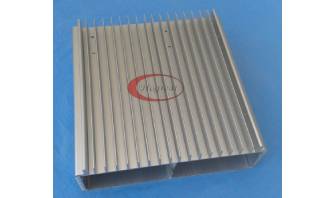Many people were curious about the forming process of the aluminum extrusion passive heat sink and how it was processed to make it look like this. Today we reveal the secret for you!
Aluminum die casting technology
In addition to aluminum extrusion technology, another commonly used process for manufacturing heat sinks is an aluminum die casting. After melting the aluminum ingot into a liquid state, it is poured into a metal model and directly die-casted using a die casting machine to form a heat sink. The pressure injection method can be used to make the fins into a variety of three-dimensional shapes, and the heat sinks can be made into complex shapes according to the needs. Increasing the heat dissipation area is widely used because of the simple process. The commonly used die-casting aluminum alloy is ADC12. Due to the good moldability of the die-casting, it is suitable for thin castings, but due to the poor thermal conductivity (about 96 W / mK), AA1070 aluminum is currently used in China as a die-casting material The thermal conductivity is up to about 200 W / mK, which has a good heat dissipation effect. However, there are some inherent deficiencies that cannot be overcome by the AA1070 aluminum die-casting radiator:
(1) Too many surface flow lines and oxidized slag during die casting will reduce the heat transfer effect.
(2) During cooling, the internal shrinkage holes are too high, and the substantial thermal conductivity decreases (K <200 W / m.K).
(3) The mold is susceptible to erosion, resulting in a short life.
(4) Poor formability, not suitable for thin castings.
(5) The material is soft and easy to deform.
With the continuous improvement of CPU frequency, in order to achieve better heat dissipation, the volume of custom aluminum extrusion cylindrical heat sink produced by the die-casting process is continuously increasing, which brings the installation of radiator There are many problems, and the effective heat dissipation area of the heat sink made by this process is limited. If you want to achieve better heat dissipation, the fan's air volume is bound to increase, and increasing the fan's air volume will produce greater noise.
Aluminum extrusion technology
The aluminum extrusion technology is simply to heat the aluminum ingot to a high temperature of about 520 ~ 540 ° C and let the aluminum liquid flow through the grooved extrusion mold under high pressure to make the initial embryo of the heat sink, and then the initial embryo After processing such as cutting and grooving, we made the aluminum extrusion heat sink that we commonly see. Aluminum extrusion technology is relatively easy to implement, and the equipment cost is relatively low, which also makes it widely used in the low-end market in previous years. The commonly used aluminum extrusion material is AA6063, which has good thermal conductivity (about 160 ~ 180W / m.K) and workability. However, due to the limitation of its own material, the ratio of the thickness and length of the heat dissipation fins cannot exceed 1:18, so it is difficult to increase the heat dissipation area in a limited space.

Aluminum Extrusion Heat Sink
Flexible process
The flexible process consists of folding a copper or aluminum thin plate into an integrally formed fin with a molding machine, and then fixing the upper and lower base plates with a puncture die, and then using a high-frequency metal welding machine to weld it with the processed base. The process is continuous bonding, suitable for high-thickness-ratio heat sinks, and because the fins are integrally formed, which is conducive to the continuity of heat conduction, the thickness of the fins is only 0.1mm, which can greatly reduce the demand for materials and be within the allowable weight of the heat sink Get the maximum heat transfer area. In order to achieve mass production and overcome the interface impedance during material joining, the upper and lower base plates are fed simultaneously during the process, and the process is automated. The upper and lower base plates are joined by high-frequency fusion welding, that is, material fusion to prevent the interface impedance from being generated to establish high strength, Heatsinks with closely spaced spacing. Because the process is continuous, it can be mass-produced, and because the weight is greatly reduced and the efficiency is improved, the heat transfer efficiency can be increased.
Forging process
The forging process is formed by heating the aluminum block to the yield point and filling the mold with high pressure. Its advantage is that the fin height can reach more than 50mm and the thickness is less than 1mm, which can get the largest in the same volume. Heat dissipation area and forging are easy to get good dimensional accuracy and surface finish. However, during forging, due to the necking phenomenon during cooling plastic rheology, the fins are prone to the thickness and uneven height, which affects the heat dissipation efficiency. Due to the low plasticity of the metal, it is easy to crack during deformation and has a large form resistance, Forging machinery that requires large tonnage (more than 500 tons) is also due to the high cost of equipment and molds, which leads to extremely high production costs. And because of the high cost of equipment and molds, the cost is too high unless mass production.
The advantage of cold forging is that a heat sink with a larger heat dissipation area than aluminum extrusion can be manufactured, and the manufacturing process of aluminum extrusion is stretched, so the aluminum metal structure is expanded horizontally, and the cold satin direction is vertically compressed, so For heat dissipation, cold forging has a greater advantage, but the disadvantage is higher cost.